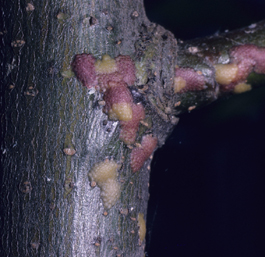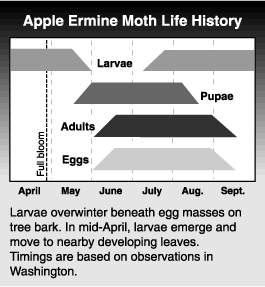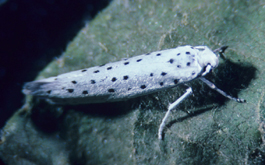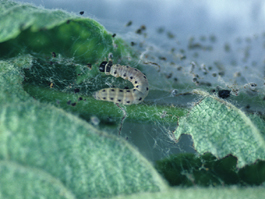by Eric LaGasa, Tom R. Unruh, and Mike Haskett, originally published 1993
Yponomeuta malinellus (Linnaeus) (Lepidoptera: Yponomeutidae)

Apple ermine moth originated in Eurasia. It was identified in British Columbia in 1981 and was first found in the United States in Bellingham, Washington, in 1985. By 1992 the pest had spread throughout Washington and northern Oregon. Its larvae feed mainly on leaves and can seriously defoliate apple trees. It primarily attacks abandoned and neglected backyard trees but could be a threat to commercial orchards using nonconventional pest control techniques such as mating disruption.
Hosts
Apple ermine moth attacks apple and crab apple (Malus spp.)
Life stages
Egg
Freshly laid egg masses are light yellow. They change to bright red within about two weeks, then fade to a cryptic gray, which is difficult to see on apple tree bark.
Larva
The larva is a caterpillar varying from gray to dark green or cream in color, with dark spots along its sides. It develops through five instars and when mature is about 3/4 inch long. The caterpillars feed within a communal web.
Pupa
The pupae, which have white cocoons, hang in clusters within the web.
Adult
The adult has silvery white forewings with rows of small black spots. Its wing span is about 3/4 inch.
Life history
 Apple ermine moths overwinter as young larvae underneath egg masses that the females deposited on tree bark the previous summer. The larvae sometimes feed on bark under the egg mass. In early spring, larvae emerge from the protective covering, or hibernaculum, and move to nearby developing leaves. At first, they mine the leaves, but towards the end of the bloom period they begin to feed within communal webs, like tent caterpillars. The webs expand to engulf more and more leaves and can be as large as a tennis ball. Apple ermine moth caterpillars may spin several tents in each tree, whereas the tent caterpillar may produce one or very few large ones.
Apple ermine moths overwinter as young larvae underneath egg masses that the females deposited on tree bark the previous summer. The larvae sometimes feed on bark under the egg mass. In early spring, larvae emerge from the protective covering, or hibernaculum, and move to nearby developing leaves. At first, they mine the leaves, but towards the end of the bloom period they begin to feed within communal webs, like tent caterpillars. The webs expand to engulf more and more leaves and can be as large as a tennis ball. Apple ermine moth caterpillars may spin several tents in each tree, whereas the tent caterpillar may produce one or very few large ones.
The larvae continue feeding in this fashion until June, when they pupate. Pupating caterpillars line themselves up neatly in tightly packed clusters. Adult moths begin to emerge in June, and females lay eggs from July into September.
Damage
If tents and larvae are numerous enough, a tree can be seriously defoliated.
Monitoring
The best way to detect apple ermine moth is to trap adults. Bait wing traps with the commercially available apple ermine moth sex pheromone and place shoulder high in apple or crab apple trees. Check every 2 weeks to avoid damage to the wing pattern by stickum. Change the lure every six weeks or more often in hot weather. The lure is effective only within about 200 feet. In May and June you can see webs containing larvae and pupae. The webs are about the size of a tennis ball or smaller and can be difficult to detect without close scrutiny, especially in large trees. Look for a gold cast on leaves that have been mined within the web. Do not confuse these webs with those of the tent caterpillar, which get much larger and extend along the branch. Searching for overwintering egg masses on the bark during fall and winter is not recommended, as the color of the hibernaculum blends in well with the bark.
Biological control
Generalist predators such as tachinid flies, birds and spiders can help control apple ermine moth. One of the moth’s most important parasites, Ageniaspis fuscicollis, a wasp from Eurasia, has been introduced and established in the Bellingham area of Washington to reduce populations and slow its spread.
Management
Apple ermine moth is not a threat where broad-spectrum insecticides are used regularly but could be a persistent pest in orchards where codling moth is controlled by mating disruption. Tents with caterpillars inside can be removed from the tree and disposed of if they are easily accessible and not too numerous. The best time for this is May. Most chemicals used to control tent caterpillars or leafrollers should control apple ermine moth also. The bacterial insecticide Bt (Bacillus thuringiensis) gives good control if applied to actively feeding caterpillars in April and May.



